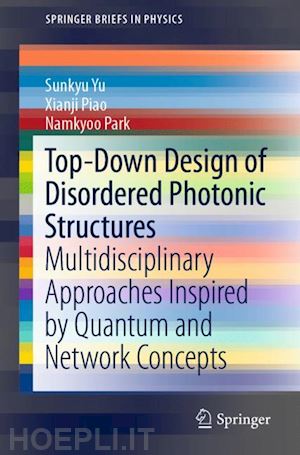
Questo prodotto usufruisce delle SPEDIZIONI GRATIS
selezionando l'opzione Corriere Veloce in fase di ordine.
Pagabile anche con Carta della cultura giovani e del merito, 18App Bonus Cultura e Carta del Docente
This book introduces recent advances in the deterministic design of photonic structures, which overcome the current limitation in conventional disordered materials. It develops new concepts for disordered photonics inspired by notions in quantum mechanics, solid-state physics, mathematics and network theory, such as isospectrality, supersymmetry, graph network, small-world, de Broglie-Bohm theory, and parity-time symmetry.
The multidisciplinary approach based on the core concepts of isospectrality (Chapter 2) and metadisorder (Chapter 3) offers a new perspective on the design methodology in photonics and in general disordered structures toward top-down designs of future photonic applications: perfect bandgap with strong modal localization, switching of random waves for binary and fuzzy logics, photonic analogy of graph networks, interdimensional signal transport, robust wave functions in disordered structures, and a novel method of energy storage and phase trapping based on Bohmian photonics. This book will provide new design criteria for physicists and engineers in photonics, and inspirations for researchers in other fields.
Chapter 1 Introduction
1.1 Order, Randomness, and Grey Area between them
1.2 Order, Randomness, and Anomalous Disorder in Photonics
1.3 Top-Down Design based on Eigensystems
1.4 References
Chapter 2 Designing Spectra in Disordered Photonic Structures
2.1 Concept of Isospectrality
2.2 Isospectrality by Supersymmetric Transformation
2.3 Application I: Supersymmetric Disorder for Photonic Bandgaps
2.4 Application II: Supersymmetric Switching of Random Waves
2.5 Isospectrality by Householder Transformation
2.6 Application: Interdimensional Wave Transport
2.7 References
Chapter 3 Designing Modes in Disordered Photonic Structures
3.1 Concept of Metadisorder
3.2 Metadisorder Configuration in Coupled Systems
3.3 Application I: Functional Wave Transport
3.4 Application II: Cloaking inside Coupled Systems
3.5 Generalization: Bohmian Photonics
3.6 ReferencesChapter 4 Conclusion and Outlook
References
Dr. Sunkyu Yu is a Postdoctoral Research Fellow in the Dept. of Electrical and Computer Engineering (ECE) at Seoul National University (SNU). He received the Ph.D. degree in ECE from SNU in 2015. The main research interest of Dr. Yu is the application of multidisciplinary views on wave phenomena, with a particular focus on disordered photonics, PT-symmetry photonics, and integrated photonics, toward the photonic realization of quantum and neuromorphic functions. He has published 28 international journal papers and 1 book chapter. He is a principal investigator of Basic Science Research Program Project for Presidential Postdoc Fellowship (’16-’20) funded by the National Research Foundation of Korea.
Dr. Xianji Piao is a Postdoctoral Research Fellow in the Dept. of Electrical and Computer Engineering (ECE) at Seoul National University (SNU). She received the Ph.D. degree in ECE from SNU in 2015. Her research interests include Fano resonances, Electromagnetically-induced transparency, and three-dimensional spinning of lightwaves on the platforms of plasmonics and metamaterials. She published 24 international journal papers and 1 book chapter. She received the Korea Research Fellowship (’16-’20) from the National Research Foundation of Korea.
Prof. Namkyoo Park is a Professor in the Dept. of Electrical and Computer Engineering (ECE) at Seoul National University (SNU). With background in Physics (’87, B.S., SNU. ’88 M.S., Brown), after finishing Ph.D. from Caltech (’94) followed by PostDoc at Bell Labs (MH, ’94-’96) and senior researcher at Samsung Electronics (’96-’97), Prof. Park started to work at the Dept. of ECE, SNU (’97~). He is a co-founder of Luxpert technologies (shipped ~ 10,000 EDFA incl. NTT Japan) and RouteJade (ultrathin LIB, yearly revenue of 20M USD). Prof. Park was also one of the four recipients of the Young Scientist Award conferred by the President of Korea in 2003, and was awarded the Scientist of the Month Award (’17). He is currently leading a team of 17 faculty members nationwide, for a 9-year project of Electromagnetic Metamaterials with a yearly budget of 2.5M USD, and was also the PIs of Global Research Laboratory (GRL), National Research Laboratory (NRL), and many industrial projects (Samsung Electronics, Korea Telecom, ETRI, KIST, etc). He served as an associate editor for Photonics Technology Letters (IEEE), Optics Express (OSA), and Optical Fiber Technology (Academic Press) for total of 16 years, and currently is a member of Advisory Board for ACS Photonics. His research portfolio includes: at present, Metamaterials (Optical, MW, Acoustic), Correlated disorder Photonics, Optical Spin- Angular- Momentum, & in the past, Photonic Logic Circuits, Optical Coding for transmission / sensor systems, Long distance optical transmission systems, and Optical Amplifiers (Erbium, Thulium, Raman, Semiconductor). He has published 3 book chapters, 163 international journal papers, presented 210 international conference papers, and holds 83 patents (34 domestic, 49 international patents).











Il sito utilizza cookie ed altri strumenti di tracciamento che raccolgono informazioni dal dispositivo dell’utente. Oltre ai cookie tecnici ed analitici aggregati, strettamente necessari per il funzionamento di questo sito web, previo consenso dell’utente possono essere installati cookie di profilazione e marketing e cookie dei social media. Cliccando su “Accetto tutti i cookie” saranno attivate tutte le categorie di cookie. Per accettare solo deterninate categorie di cookie, cliccare invece su “Impostazioni cookie”. Chiudendo il banner o continuando a navigare saranno installati solo cookie tecnici. Per maggiori dettagli, consultare la Cookie Policy.